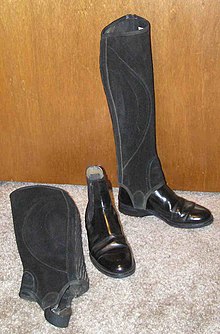Chaps

Chaps (from Spanish chaparajos) are leather trousers without buttocks that are worn by cowboys when riding. The chaps should protect the legs and also the pants, e.g. B. in front of thorn bushes, in front of the horns of cattle, when working with the lasso or when doing hoof work from injuries with a hoof knife. Specialized forms of waterproof work protection are also worn by other professionals as work protection (e.g. farriers, screed layers, gardeners and landscapers and forest workers).
There are other forms of chaps: the narrow shotguns , which are now mainly worn in the north, the wide-cut open batwings , which are particularly common in hot Texas, and, especially in California, the chinks that only reach just below the knee . In the north, woolies are worn in winter , which are chaps made from goat hair that are also mostly lined. However, these have the disadvantage that they soak themselves up with water when it rains and thus become very heavy. They also give off a foul odor when wet. In Spain the vaqueros wear Zahones .
history
Similar leather garments were already in use by some Native American tribes . They were taken over by white trappers and hunters (“ leather stockings ”). Today they are made as a kind of leather leggings or a kind of leather pants without a crotch, the waistband of which is belted at the front and / or laced at the back. They only cover the legs and sometimes only their front or back, as they can be worn as protection over the actual pants.
The English riders are widely known as Chaps , a sort of gaiters , often in combination with z. B. Jodhpur boots or other shoes are worn as a substitute for riding boots .
Chaps are also popular in the rocker scene and in the subculture of the gay leather scene .
Modern occupational safety
Splash guard
When working with the brushcutter , spray protection chaps are worn by municipalities, gardeners and forest workers to keep flying stones, broken glass and wet grass away from their legs. They are always made of absolutely waterproof material (mostly synthetic leather) and are therefore also used for working with the high-pressure cleaner. The chaps for hunters are usually thorn-proof and cut higher, they are with or without fasteners and protect against moisture and thorn bushes.
Kneeling works
These chaps are equipped with knee pads on the inside, and have a very robust material on the outside, which keeps stones, acids and bases away. They are usually made of absolutely waterproof material and are one size fits all. The chaps lie loosely around the leg, are attached to the belt or waistband with elastic and clips and range from two hand's breadth above the knee to the hem. The closures are on the back and are differently tailored to the individual industries. Chaps are an alternative to knee pads , as they do not constrict and protect the entire leg from moisture and dirt. They are worn by screed layers, tilers, gardeners and pavers and farriers. These special work protection chaps must always be certified via the knee protection certification DIN EN 14404.
Cut protection
The chaps are used for sawing work as an alternative to cut protection pants . They are ideally suited for short use in gardening and landscaping, in agriculture, for private individuals and forest workers. As with chainsaw protection trousers, these chaps prevent the saw from injuring the leg in an accident. These chaps must always be certified according to DIN EN 381-5 cut protection.
